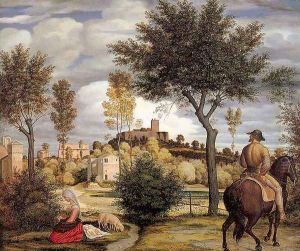Woldemar Friedrich Olivier Paintings
Woldemar Friedrich Olivier was a notable German painter associated with the early Romantic period. Born on April 15, 1791, in Dessau, Germany, he was part of a family with a strong artistic background; his brothers Ferdinand Olivier and Heinrich Olivier were also accomplished painters. Woldemar's work was profoundly influenced by the aesthetic and philosophical ideas that characterized the Romantic movement, which emphasized emotion, nature, and individualism.
Olivier received his early education in art under the guidance of his father, who was a court painter. He further developed his skills in Dresden, where he joined his brother Ferdinand and studied under the painter Johann Friedrich Matthäi. His education continued in Vienna and Italy, which was a common destination for artists seeking to study classical art and the Renaissance masters. His Italian sojourn, particularly in Rome, played a crucial role in shaping his artistic vision. There, Olivier became part of a circle of German artists known as the Nazarenes, a group that sought to revive the spirituality and purity they saw in medieval and early Renaissance art.
Olivier's work is characterized by its attention to detail, use of vibrant colors, and incorporation of religious and mythological themes. Like his Nazarene peers, he often employed these themes in an attempt to convey moral and spiritual messages through his art. Although less well-known than some of his contemporaries, Olivier contributed to the broader tapestry of 19th-century German Romantic painting. He was particularly skilled in landscapes, which he infused with a sense of the divine and an appreciation for the natural world. His landscapes were not merely representations of the environment but also imbued with emotional resonance and a sense of the sublime.
Woldemar Friedrich Olivier's career was somewhat overshadowed by that of his brother Ferdinand, who gained greater fame. Nonetheless, Woldemar's artistic output remained consistent and dedicated to the principles of the Romantic movement until his death on August 12, 1859, in Munich, Germany. Today, his works can be found in various art collections and museums, serving as a testament to his role in the development of 19th-century German art.
